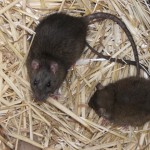 We get a lot of questions about rats. What do rats like to eat? Why are rats in my home? What do rat droppings look like? How do I get rid of rats?
We get a lot of questions about rats. What do rats like to eat? Why are rats in my home? What do rat droppings look like? How do I get rid of rats?
Roof rats, Norway rats, black rats, pack rats, kangaroo rats, naked mole rats, cotton rats. Not all creatures called “rats” are actually of the rat family, but when you’re dealing with a rat infestation, you probably don’t care what type of rat you have, you just want them gone. Unfortunately, different types of rats behave differently, which means that you need to know what kind of rats are breeding around you so that you can most effectively get rid of them. That’s one real advantage to having a rat catcher / wildlife removal expert. With a little investigation, they can tell what kind of rats are infesting your house or building, and they have the expertise and tools to get rid of that particular type of rat.
Rat teeth are constantly growing, so a rat must continually gnaw on things to keep them a manageable size. Combine that need with strong teeth and powerful jaw muscles, and rats can chew through pretty much anything, including concrete and lead pipes. A rat can bite with the force of 12 tons per square inch (a great white shark bites with 20 tons per square inch.) Ouch!! So, once rats are in a building or a home, anything is fair game for gnawing. Wood joists, wires, boxes, soffit, pretty much any building material and personal property.
Rats will eat pretty much anything and gnaw on everything. They are opportunistic feeders, which means if they can get at it, they’ll eat it. Grains, meat, fish, seeds, fruit, snails, insects, pet food, leather, fur and other rodents. Keeping lids tight on garbage cans, getting rid of bird feeders, and cutting off access to gardens and food storage will all help limit a rat’s access, but they’re quite capable of climbing, jumping and chewing their way in if they’re determined. Allstate Animal Control has a slick rodent barrier that prevents rodents from digging under a fence and climbing up fences, trees or telephone posts to gain access to a food source.
Rat droppings are compact black pellets that look very much like a bean or raisin. Their droppings usually measure about ¼ to ¾ of an inch long, and are usually found in their traffic areas, outside the structure, by window wells, window ledges, or access holes.
Rats can get into a home through a tiny opening. Holes left by woodpeckers, openings around pipes, a weak soffit or other roofing material are excellent access points for rats, and you may notice the entryway is black and greasy from a rat’s body oils. Finding and sealing one opening, though, may not be enough. They will likely have more than one entrance point. Again, a professional rat trapper can inspect your building or home, locate and seal up these little holes.
Picking up a few traps at a hardware store and setting them around heavily trafficked areas is definitely an option for homeowners, but since rats are such prolific breeders, it’s likely you have more rats in the walls or attic or under the floor than you can see or catch. Rat poison is another option, but introduces possible harm or even death to children or animals who get overly curious. Also, rats are smart and learn to quickly avoid most poisons set out for them. Keep in mind that rats pack a painful bite, carry diseases (sometimes fatal diseases), and get very feisty and ornery when cornered. The absolute best way of getting rid of rats is to have a professional trapper come out to your building. They have the expertise, the tools and the experience to find out which kind of rat you’re dealing with, use the most effective methods of exterminating rats or trapping rats or killing rats, and do what is needed to keep rats from coming back.